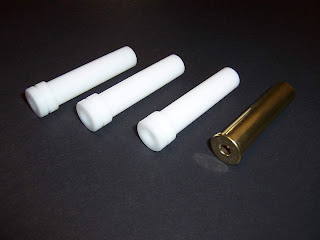 |
| Our New 22 Long Rifle Chamber Guide |
Due to demand from our Rimfire Schuetzen Shooters, we have decided to add a 22 Long Rifle chamber guide to our line of products. Like our other chamber guides, they are designed to work in the various single shot actions listed below. The new 22 Long Rifle chamber guides are designed to work with rod diameters of .187" or smaller. These new chamber guides when combined with our 223 caliber jags and brush guides will provide the user with the utmost protection for their barrels, from chamber to crown.
 |
| 45-70 Chamber Guides |
Our chamber guides are made to go on your rod and then you screw the appropriate jag or brush guide or brush on. You then push the appropriate tool thru the chamber and into the barrel slightly. Then you seat the chamber guide into the chamber and continue pushing the rod thru the barrel. When removing the rod, the jag or brush guide or brush will bump into the chamber guide and remove everything as one unit. (See note 1.)
By using a chamber guide in this manner you are accomplishing two things to help maintain your rifle. First of all you are maintaining proper rod alignment while cleaning. (See note 2.) Secondly, while pulling a brush back into the chamber area the chamber guide will block most of the debris being flicked ahead of the brush by it’s bristles as they clear the throat area. In actual use you will notice that the action area especially the mortises stay much cleaner because of this.
The reasons that we don’t bore the hole in the guides large enough to actually pass the cleaning tools thru are these: First of all we want the guide to provide the best possible alignment for the rod to help alleviate the lapping action of the rod against the bore as much as possible especially in the throat area. Secondly, we don’t want the solvents that would get pressed out of the patches or the brushes, while entering the guide, to end up in the action and trigger of the rifle.
 |
| 22-250, 280, and 308 Chamber Guides |
Note 2. When you get up into the larger calibers and while using my chamber guides along with my bore riding jags or brush guides your rod should never come into contact with the bore. This helps alleviate the lapping action that can sometimes be imposed upon a bore for almost the full length of the rod.
